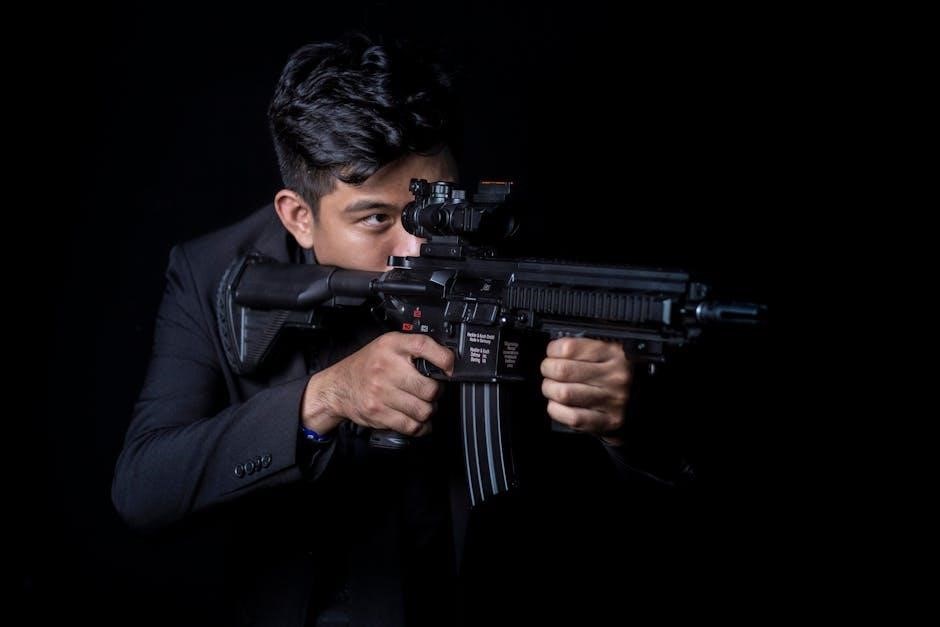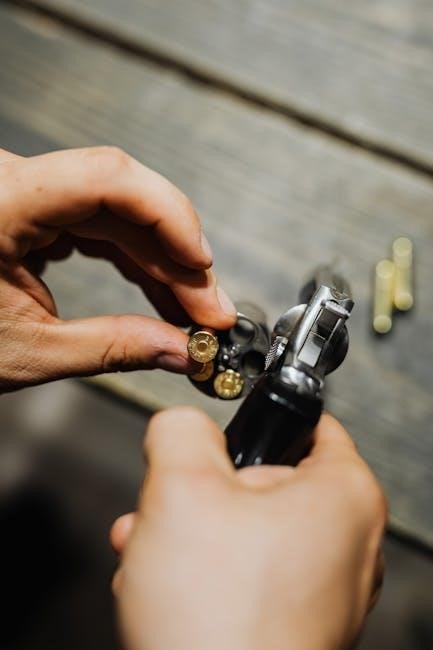Firearm safety mechanisms, such as manual safety and trigger safety, are essential for preventing accidental discharges, ensuring safer handling, and promoting responsible gun ownership practices․
Overview of Manual Safety and Trigger Safety
Manual safety and trigger safety are two distinct mechanisms designed to prevent accidental firearm discharges․ Manual safety involves a physical lever or switch that must be intentionally disengaged before firing, offering an additional layer of control․ Trigger safety, on the other hand, relies on integrated components that block the trigger unless pressed correctly, reducing the risk of unintended activation․ Both systems aim to enhance firearm safety, but they cater to different preferences and scenarios․ While manual safety provides a tangible control option, trigger safety offers seamless integration with the firearm’s operation, making it a popular choice in modern pistols․ Each mechanism has its unique benefits and use cases, reflecting the diversity of safety needs in firearms․
Importance of Firearm Safety in Modern Weapons
Firearm safety mechanisms are critical in preventing accidental discharges and ensuring responsible gun ownership․ Modern weapons often integrate advanced safety features to minimize risks, particularly in self-defense and concealed carry scenarios․ These mechanisms not only protect users but also bystanders, reducing the likelihood of unintended harm․ Safety features like manual and trigger safeties are essential for ethical and legal firearm use, emphasizing the importance of proper handling and storage․ As firearms evolve, so do safety standards, reflecting a commitment to reliability and user confidence․ Prioritizing safety ensures that firearms remain tools for protection rather than potential hazards, aligning with societal expectations for responsible weapon ownership․
Understanding Manual Safety
Manual safety is a physical mechanism, often a lever, designed to prevent accidental discharge by blocking the firearm’s action when engaged․
Definition and Mechanism of Manual Safety
Manual safety refers to a physical mechanism, typically a lever, designed to prevent accidental discharge by blocking the firearm’s action․ Located on the side, it stops the trigger from being pulled or the firing pin from striking the primer․ Engaging the safety ensures the firearm cannot fire, even if the trigger is accidentally activated․ This feature is particularly useful for carrying loaded weapons, as it adds an extra layer of security․ The mechanism is simple: flipping the lever upward engages the safety, while flipping it downward disengages it, readying the firearm for use․ This design provides a clear, tactile indicator of the firearm’s status, enhancing safety and control for the user․
Pros of Manual Safety in Firearms
Manual safety offers an additional layer of security, preventing accidental discharges when engaged․ It provides a clear, tactile indicator of the firearm’s status, giving users confidence in carrying loaded weapons․ This feature is particularly beneficial for concealed carry, as it reduces the risk of unintended firing․ Manual safety also allows for deliberate control, ensuring the firearm only fires when intentionally activated․ For shooters who value an extra safety step, manual safeties enhance situational awareness and reduce the likelihood of negligent discharges․ However, it requires consistent training to ensure proper engagement and disengagement, making it a preferred choice for disciplined users․
Cons of Manual Safety in Modern Pistols
Manual safety mechanisms can pose challenges, particularly in high-stress situations where split-second decisions are critical․ The risk of forgetting to disengage the safety during an emergency can lead to failure to fire when needed․ Additionally, the physical act of manipulating the safety can be cumbersome, especially for users with limited dexterity or during rapid draws․ Modern pistols often omit manual safeties, as they can complicate the user experience․ Furthermore, reliance on manual safeties requires consistent training to ensure proper engagement and disengagement, which may not always be practical․ This has led many to favor trigger safety systems, which are inherently more intuitive and less prone to user error․
Understanding Trigger Safety
Trigger safety mechanisms are designed to prevent accidental discharges by requiring intentional trigger activation, often incorporating passive systems integrated into the trigger itself for enhanced security․
Definition and Mechanism of Trigger Safety
Trigger safety refers to a firearm mechanism designed to prevent accidental discharge by requiring deliberate activation of the trigger․ It typically involves a safety lever or component within the trigger system that must be intentionally pressed or moved to fire the weapon․ This mechanism ensures that the gun cannot discharge if the trigger is not fully pressed, reducing the risk of unintentional firing․ Trigger safeties are commonly found in modern pistols, such as those with striker-fired designs, and are often integrated into the trigger itself, providing an additional layer of safety without the need for a manual safety lever․
Pros of Trigger Safety in Firearms
Trigger safety offers several advantages, primarily by preventing accidental discharges without requiring manual engagement․ It is inherently intuitive, as the safety mechanism is built into the trigger, ensuring the firearm cannot fire unless the trigger is intentionally pressed․ This design simplifies operation, eliminating the need to manipulate a separate safety lever, which can be beneficial in high-stress situations․ Trigger safeties are also less prone to being inadvertently disengaged, providing consistent reliability․ Additionally, they streamline the firearm’s design, reducing the number of external controls and making the weapon lighter and more ergonomic․ This makes trigger safety particularly appealing for concealed carry and everyday use․
Cons of Trigger Safety in Modern Pistols
While trigger safety mechanisms are effective, they have certain drawbacks․ One notable disadvantage is the potential for unintended trigger engagement, particularly if the trigger is inadvertently pressed․ This risk is heightened in stressful situations where proper trigger discipline might be compromised․ Additionally, trigger safeties may not prevent accidental discharges caused by drops or external objects pressing the trigger․ Some users find trigger safeties less reassuring than manual safeties, as they rely on mechanical components that could potentially fail․ Furthermore, trigger safeties can complicate maintenance and repair, as they are often integrated into the trigger system, making them harder to inspect or replace without specialized tools․

Manual Safety vs․ Trigger Safety
Manual safety requires physical engagement, offering a clear, tactile way to secure firearms, while trigger safety relies on internal mechanisms to prevent accidental discharge, appealing to different user preferences and trust levels․
Key Differences Between the Two Systems
Manual safety involves a physical lever that must be deliberately disengaged, offering a clear tactile indicator of the firearm’s status․ Trigger safety relies on internal mechanisms that block the firing process unless the trigger is fully pressed․ Manual safety provides an additional layer of control, while trigger safety reduces the risk of accidental discharge during holstering or handling․ Manual safety is often preferred for its simplicity and direct engagement, whereas trigger safety is valued for its seamless integration into the firearm’s operation․ Both systems aim to enhance safety but cater to different preferences and shooting styles, making them suited for varied situational needs․

Reliability and Performance in Real-World Scenarios
Manual safety and trigger safety differ in reliability and performance during real-world use․ Manual safety requires intentional disengagement, reducing accidental discharges but potentially causing delays in high-stress situations․ Trigger safety automatically prevents firing unless the trigger is fully pressed, offering passive security without user intervention․ In chaotic scenarios, manual safety may be inadvertently left engaged, while trigger safety ensures the firearm operates when needed․ Trigger safety is less prone to human error, making it ideal for concealed carry, whereas manual safety relies on proper handling․ Both systems excel in preventing accidents but cater to different operational preferences and situational demands, showcasing their unique strengths in practical applications․
Choosing the Right Safety Mechanism
Choosing the right safety mechanism depends on understanding the differences between manual and trigger safety, considering personal preference, usage scenario, and ease of use effectively․
Situational Use of Manual Safety
Manual safety is ideal for specific situations, such as concealed carry or high-stress environments, where an extra layer of control is desired․ It provides a physical barrier against accidental discharges, offering peace of mind for users who prioritize added security․ However, it requires deliberate action to engage or disengage, which may not be suitable for rapid-response scenarios․ Manual safety is particularly beneficial for shooters who are trained to rely on it as part of their drawing or handling routine․ Despite its advantages, it is less common in modern pistols, as many favor trigger safety for its simplicity and instinctive operation․
Situational Use of Trigger Safety
Trigger safety is widely embraced for its intuitive design, making it ideal for self-defense and rapid-response situations․ It ensures the firearm only fires when the trigger is intentionally pressed, reducing accidental discharges without requiring manual activation․ This mechanism is particularly advantageous in high-stress scenarios where split-second decisions are critical․ Trigger safety systems are commonly found in striker-fired pistols, such as the popular Glock, and are favored by law enforcement and civilians alike․ Their reliability and simplicity make them a practical choice for users who prioritize ease of use and immediate readiness․ This feature is especially beneficial for those who may not have extensive training in manual safety protocols․
Best Practices for Firearm Safety
Regardless of whether a firearm features manual or trigger safety, adhering to best practices is crucial for safe handling․ Always treat the gun as if it is loaded, ensuring the muzzle is pointed in a safe direction․ Keep fingers off the trigger until ready to shoot, and use proper holsters to prevent accidental discharges․ Regular training and practice with the specific safety mechanism are essential to build muscle memory and confidence․ Additionally, familiarize yourself with local laws and regulations regarding firearm safety․ By combining these practices with the chosen safety mechanism, users can maximize safety and effectiveness in various situations, ensuring responsible gun ownership and operation․


Final Thoughts on Manual Safety vs․ Trigger Safety
Manual safety and trigger safety each offer distinct benefits, catering to different priorities․ Manual safety provides an additional layer of control, appealing to those who prefer an extra failsafe․ Trigger safety, on the other hand, is seamless and intuitive, ideal for quick action scenarios․ Both mechanisms have proven reliable, but their suitability depends on the user’s training, lifestyle, and specific needs․ While debates continue, the choice ultimately hinges on personal comfort and trust in the system․ Balancing convenience, reliability, and situational awareness is key to making an informed decision․ Each option has its merits, ensuring safer firearm handling․
Future of Firearm Safety Mechanisms
The future of firearm safety mechanisms is likely to involve advanced technologies that enhance security without compromising functionality․ Innovations such as smart guns with biometric locks and AI-driven safeties could revolutionize the industry․ These systems would prevent unauthorized use, reducing accidents and misuse․ Additionally, user-centric designs may integrate customizable safety features, allowing owners to tailor mechanisms to their preferences․ As technology evolves, the focus will remain on balancing safety, reliability, and accessibility․ The integration of training simulators and AI-driven safety protocols could further enhance user education and mishap prevention․ The goal is to create firearms that are both secure and intuitive for responsible owners․

Leave a Reply
You must be logged in to post a comment.